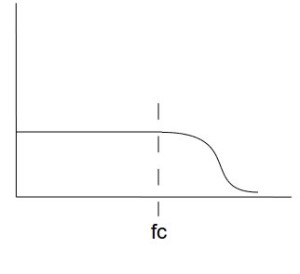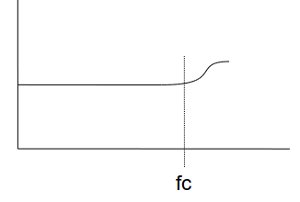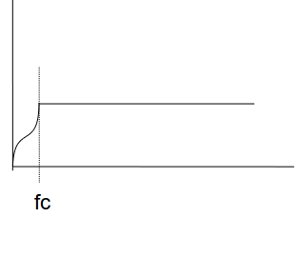There are different kinds of low pass filter, I personally use Butterworth filters in Adobe Audition order 66. Most commercial master recordings apply a low pass filter at around 16500Hz (this is done in the EQ stage of the mastering process). However, it is not popular to use a low pass filter in mixing process.
HIGH SHELF FILTER
Definition: A high shelf filter will cut or boost signals of frequencies ABOVE “fc”. Below the cutoff frequency, the input signal is unaffected. This operates opposite to a low shelf filter. Below is the response output of a high shelf filter used in cutting signals above “fc”.
A common implementation of high shelf filter reduction is similar to a low pass filter such as noise filtering. Unlike a low pass filter which is designed only for “attenuation” or “cutting signals”. A high shelf filter can also be used to boost signals above the cut off frequency, such as below:
A typical example is boosting high frequencies. For example in a digital audio music mastering process, the engineer might noticed that there is a significant lack of high end frequency response. To solve this problem, the mastering engineer can use a high shelf filter to slowly boost the high end frequencies.
HIGH PASS FILTER
Definition: A high pass filter will pass signals of frequencies above the cutoff frequency unaltered and drastically attenuate signals of frequencies below that value. Just like low pass filter, a high pass filter is only used for the attenuation of signals or cutting. It is not designed for boosting. Below is a typical response output of a high pass filter:
As you have noticed, high pass filter operates similarly to the “cutting” mode of a low shelf filter. But high pass filter drastically reduces the signals below the cutoff as compared to a low shelf filter.A common implementation is when mixing bass guitar vs kick drums. In rock music, bass guitar commonly occupies the bottom subwoofer frequencies while the kick drum is above the bass guitar. The mixing engineer can use a high pass filter on kick drums to cut its lower bass spectrum in favor of the bass guitar.
I commonly use this filter during mixing but not so much in the mastering process. HPF can be applied to vocals, guitars and other string instruments to avoid mud with the bass guitar or bass frequencies.
One important distinction of high pass and low pass filters with the rest of the filters (like parametric equalizers) is the absence of Q in the settings. So if you are going to use high pass/low pass filters, you need to set one important value and that is just be the “cut off frequency”. Although in some scientific filters you need to set the “order”, which is the measure of steepness of the frequency attenuation
Summary
1.) A low shelf filter operates similarly with a high pass filter in cutting mode.
2.) A high shelf filter operates similarly with a low pass filter in cutting mode.
3.) A high pass filter is not the same as the low shelf filter because low shelf filters can be used in boosting signals while a high pass filter is limited only to attenuation.
4.) A low pass filter is not the same as a high shelf filter because low pass filter cannot be used to boost signals unlike a high shelf filter.
For best results, you might want to cut not more than -12dB on shelving filters. More than that, it is recommended to look into re-recording the affected track as over-EQ could introduce some artifacts. The maximum boost recommended would be around +3dB on high shelf boosting mode. You would also consider re-recording the track if you find to boost more than this amount. For example you find the cymbals and hi-hats sound lacking in treble definition, instead over-boosting it in mixing, it might be good that it would be re-recorded using proper microphone and placement.
Content last updated on June 14, 2012


